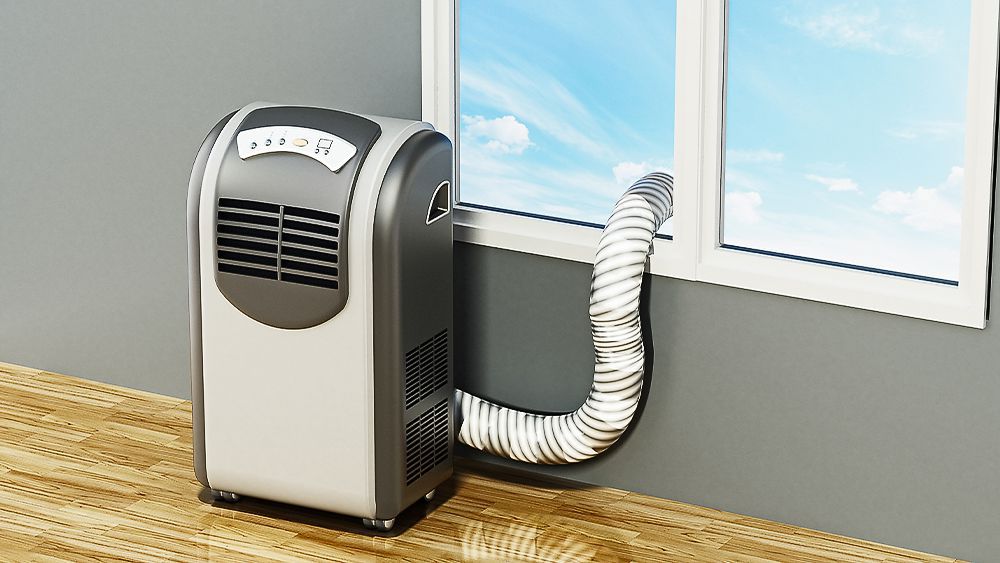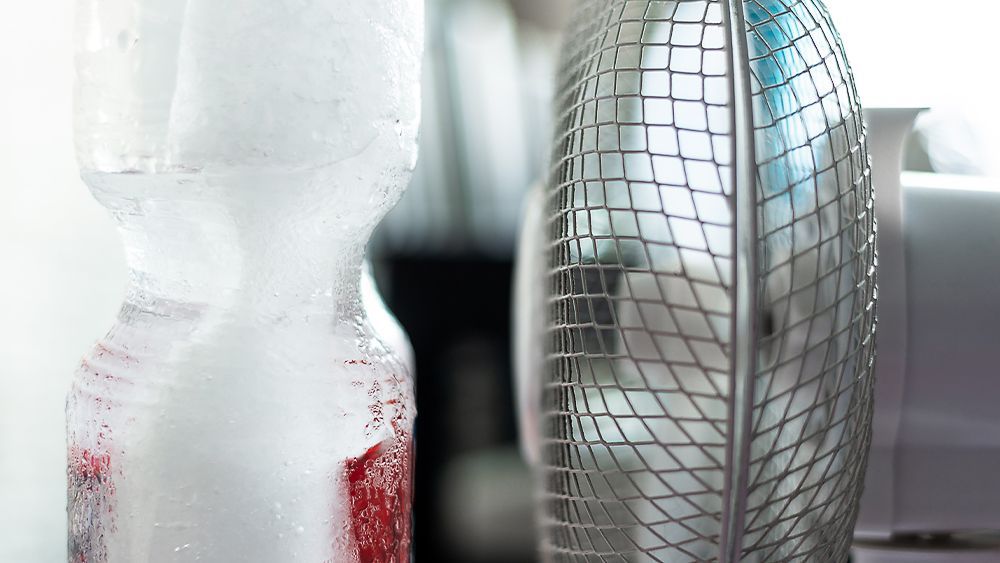
Key Takeaways
- Portable ACs offer easy installation, can be detached effortlessly, making them an ideal choice for dorm rooms.
- Pair you portable unit with smart AC controllers to boost comfort and cut energy costs.
- If your dorm prohibits AC, opt for a portable fan, keep blinds closed and turn off excess electronics to stay cool.
Dorm rooms can often get unbearably hot, giving you a hard time sleeping or studying. On top of all the study pressure, the last thing you want is to come back to a hot and stuffy dorm. Not to mention how inadequate sleep can also lead to difficulty retaining important information.
It’s time to put an end to your misery by getting a personal dorm room air conditioner. But it’s always a good idea to check with the rules of your university. Some institutes allow students to use personal air conditioners while others don’t, citing the low electrical capacity of older dorms or fearing high electricity bills. Whether your university allows air conditioners or not, you can find out by consulting the student handbook or asking the administration.
From helping you decide the best air conditioner for your dorm to cooling your room without AC, this guide has got you all covered.
Best Air Conditioners for Dorm Rooms
If your dorm does allow air conditioners, you’re in luck. As far as which type of air conditioner you should get, a portable air conditioner is the most suitable option for a dorm. It is improbable that your college will allow you to damage the structure and install a mini-split or a window AC. Portable air conditioners can be installed and uninstalled at a moment’s notice. Once summer ends, you can quickly detach your portable air conditioner and store it for next summer. Also, when relocating, you can easily pack it up and take it with you.
Portable Air Conditioners

Portable air conditioners are much more effective at cooling your room than air coolers. While they require a hose to be vented out of a window, they actually condition the air.
Portable ACs are also easy to install and cost-effective, making them a no-brainer for most college students. If you buy a portable heat pump, you can benefit from it all year long. They can provide cooling during summer and heating during winter. They are a much more efficient and safer option than a space heater.
However, portable air conditioners do have a few drawbacks you should be aware of. Firstly, they are not as effective as window units or mini-splits. Secondly, they are noisier than other systems. Finally, portable AC’s need to be placed near the window for effective heat removal through their hose.
How Much Does a Portable Air Conditioner Cost?
Before committing to a portable air conditioner for your dorm, you need to know how much it costs to buy, how much it costs to install, and how much it costs to run.
Some low-budget portable air conditioners can cost as little as $50. However, those are unlikely to be very effective.
Most portable air conditioners do not have any associated installation costs since setting them up requires no complex work. You can easily DIY the installation. They are plug-and-play devices. All you need to do is extend the flexible hose through your window to vent the air outside. This is it; you’re all set to enjoy a comfortable room temperature.
A portable air conditioner’s running cost is where you must pay the most attention. An unexpectedly high running cost can upset your entire budget. According to SFGATE, running a small portable air conditioner eight hours a day for a month can cost around $85.20.
Pro Tip: The best way to maintain your ideal room temperature while also keeping the bills in check is to connect your portable air conditioner with a smart AC controller. Cielo Breez smart controllers help you save up to 25% on your energy costs. With smart features like Comfy Mode, weekly scheduling, global control, you can automate your dorm room AC without worrying about manually changing temperature every now and then.
Your best choice to make any mini-split, window,
or portable AC smart. Enhance your comfort and savings.

What to Look For When Buying a Portable Air Conditioner
Before making your purchase, pay attention to the following things:
1. Smart Functionality
Dorm room air conditioners that are smart can save you from a lot of misery. But you can make any stand-alone air conditioner smart with a smart thermostat for room units. These cost way less than the AC and come with a range of options promising a comfortable dorm!
You can utilize geofencing for your air conditioner to switch off automatically as you leave campus to save energy. You can set schedules for your dorm room air conditioner to switch on right as your class time ends – this way you will enter a nicely precooled room! Moreover you can control your AC using your phone from anywhere or make use of other additional features.
2. Sizing
Air conditioners are rated in British Thermal Units (BTUs) per hour. Models with higher BTUs provide more cooling power and are more appropriate for larger spaces. On the other hand, lower BTU models are more suitable for small areas such as dorm rooms.
Use this air conditioner sizing guide to figure out how many BTUs you need according to the size of your dorm room.
3. Noise
One of the main drawbacks of portable air conditioners is their noise level. No one wants to be distracted while studying by the sound of an AC. Try to go for the model that has a lower decibel rating. You can also place a rug under your portable AC to minimize its noise.
4. Placement
While cooling, portable air conditioners produce hot air which needs to be expelled outside. For this purpose, you must place them near a window. Before buying a portable AC, check if you have a suitable window with a power socket near it to plug in the AC.
5. Efficiency
Since most college students are cash strapped, you need to pick a portable AC that is highly energy-efficient to minimize energy bills. Look at the EER and SEER ratings to determine how energy-efficient a particular unit is. The higher the EER and SEER rating, the more energy-efficient the unit is.
Related: Are Portable Air Conditioners Worth It? Weighing the Pros & Cons
Best Portable Air Conditioners for Dorm Room
After you’ve gone through all the considerations, it’s time to choose your portable AC, and here are some of our top picks.
1. FHPH132AB1 Portable Room Air Conditioner by Frigidaire
If you are easily distracted by noise, this ultra-quiet portable air conditioner is just the thing for you. Apart from being quiet, it comes with a built-in dehumidifier and can heat and cool your room. The only downside is that its price is at the higher end.
2. Black + Decker BPACT08WT Portable Air Conditioner
Having an oversized air conditioner is wasteful and can lead to high energy bills. If your dorm room is smaller than average, the Black + Decker portable AC is perfect for your needs. This 5000 BTU DOE air conditioner can effectively cool rooms up to 150 sq. ft.
3. Portable Evaporative Cooler with Fan by Honeywell
Retailing at just $179.99, this is a fantastic and cheap option for college students. You don’t need to hook it to a window, so you have more flexibility when deciding where to place it. However, this is not the most powerful unit, so if you want something that provides an intense chill, this is not the one for you. It’s a cooler rather than an air conditioner.
Air Cooler vs. Portable Air Conditioners
Air coolers are a cheap and effective alternative to portable air conditioners. Though air coolers aren’t as effective at cooling as air conditioners, they offer significantly better air quality and are cheaper.
Air coolers don’t use a refrigerant and cool the room down using water and a fan motor. This makes them more eco-friendly. However, this also means that they humidify the room by adding moisture. Excessive humidity can lead to mold growth. You can reduce humidity by coupling the air cooler with a dehumidifier. In extremely humid areas, air coolers aren’t an effective solution.
How to Build a DIY Dorm Room Air Conditioner
If you’re looking for a challenge, you can even build a DIY dorm room air conditioner for just about $40. You’ll require a standing fan, copper tubing, inner diameter rubber tubing, zip ties, small hose clamps, and two buckets.
Detach the face of your fan and start coiling copper tubing around it using zip ties. Using hose clamps, secure rubber tubing onto either end of copper tubing. Fill one of the buckets with water and place it above ground level. Siphon the water to another bucket on the floor and turn on the fan. Dispose of the lukewarm water collected in the floor bucket. You’d have to keep emptying the bucket a few times to feel a change in your dorm room temperature.
Here’s a quick tutorial for you:
How to Cool a Dorm Room Without Using an Air Conditioner
Are you one of those unlucky souls whose colleges do not allow air conditioners in the dorm? Don’t lose hope yet. There are some steps you can take to stay cool without an AC.
1. Purchase a Fan

Invest in a decent portable fan, and you won’t regret it. Though fans can’t lower the temperature, they can make you feel cooler by wicking away sweat. To maximize the performance of your portable fan, place a block of ice behind it before turning it on. The ice block will create colder air, similar to an air conditioner.
2. Keep Your Blinds Closed
During summers, about 76% of the sunlight that falls on standard double-pane windows becomes heat. While the sun’s rays are at their strongest, keep your curtains drawn. Since heat radiates through the windows, warming up your room, closing the curtains will reflect much of that heat away. Curtains with a white plastic backing are the best at reflecting heat.
3. Invest in a Cold Mist Humidifier
Cold mist humidifiers or evaporators emit cool vapors to add moisture to the air. They are better suited for warm climates since they create a cooling sensation while adding moisture to the air. Their downside is that they are noisier and are more prone to bacterial growth. If you do invest in a cold mist humidifier, clean it regularly.
4. Turn Off Unnecessary Electrical Appliances
Electrical appliances such as light bulbs, kettles, and irons also generate a lot of heat. One or two electrical appliances don’t make a difference, but multiple appliances will significantly heat your dorm room. During summers, turn off any excess electrical appliances, including light bulbs.
5. Shower Before Bed
If all else fails, you can always hop into the shower for a quick cold bath. Cold showers are great at making you feel cooler; however, warm showers are better at reducing body temperature in the long run.
While the lack of dorm room air conditioners is the bane of (almost) every student’s existence, you can do much to reduce the temperature and get a good night’s sleep. With these tips and tricks at your disposal, you will definitely have a comfortable time studying and partying in your little room.








